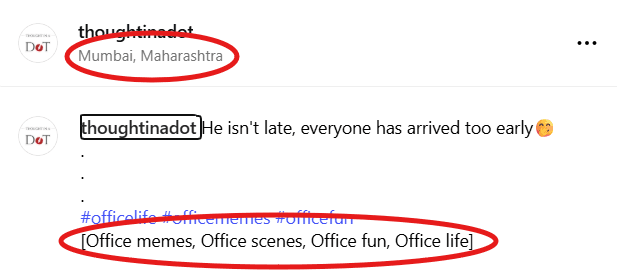We are the most connected we have ever been in the history of humankind. Social media and digital innovation have made it possible to reach and connect with anyone with access.
One of the most influential platforms in recent years has been the Meta-owned Instagram. Over the years, Instagram has turned from a visuals-only platform to a connected experience that caters to 2 bn+ users worldwide. Today, it has become a true tool of influence for creators as well as marketers.
The networking app’s influence on search isn’t just social buzz anymore. With its access, Instagram now also affects SEO on two levels. Indirectly, strong Instagram content marketing builds brand awareness and drives traffic, which in turn boosts search authority.
For example, highly engaging posts can attract clicks and even backlinks (from bloggers or news sites that pick up trending content), sending positive quality signals to search engines.
Instagram also drives branded searches: when users repeatedly see your brand on social, they are more likely to Google it, which Google treats as a sign of authority. Directly, Instagram has now become part of the Google index.
As of July 10, 2025, Google (and Bing) began indexing public Business and Creator Instagram accounts. That means your public posts, Reels, carousels, captions and even hashtags can now show up in search results.
In short, Instagram content can compete alongside blogs and news articles for keywords. A local gym’s Reel about “correct squat form” might rank on Google just as a YouTube video or article would. This is a fundamental shift in social content for Instagram that can now rank in web search, giving brands another route to SEO visibility.
What does Instagram’s new search-indexing update involve?
Instagram’s July 2025 update essentially “turns on” search for eligible accounts. It applies only to public Business or Creator profiles (not personal/private or accounts of under-18 users)
Meta’s guidelines say content from these professional accounts since January 1, 2020 can be crawled. Specifically, search engines can index posts, Reels, carousels, videos, captions, and hashtags from those accounts.
(Note: Instagram Stories and Highlights are not indexed, and personal/locked accounts are excluded.)
In practical terms, this means Google and Bing can show your Instagram content in relevant searches. So, if you tag a post “#MumbaiRealEstate,” someone searching “Mumbai Real Estate” on Google might see that Instagram post in results. Meta even lists key details: search indexing began July 10, 2025 (with newer, highly engaged content prioritized).
Businesses can opt out by switching to a personal profile or setting their account to private. In essence, Instagram has “torn down the wall” between social and search; your public Instagram content outside the app is now discoverable through web searches.
How can I optimize my Instagram posts to boost search visibility?

Treat Instagram posts like mini web pages optimized for search. Follow these practices:
Use Keywords in Captions: Write naturally flowing captions that include the search terms your audience uses. For example, if you run an apparel business, mention “ladies office shirts,” “satin formal shirts,” or your city name in the caption. As one expert advises, “think of Instagram content like landing pages” – align captions with keywords and intent
Write Detailed Alt Text: Always add alt text for images and videos. Describe the media with relevant keywords (in 100–125 characters). Google indexes this text, so a concise, keyword-rich alt description can help your post appear in Google Image or web search
Include Hashtags Strategically: Add several targeted hashtags in the caption (not comments) to categorize your content. Hashtags function like SEO tags, giving Google extra context. Mix popular broad tags with niche ones (e.g. #realestate (broad) + #MumbaiRealEstateDevelopers (niche)).
Use Location and Profile Links: If relevant, tag your location to appear in local searches. Also, optimize your Instagram bio including clear keywords and a link to your site. A public profile with a keyword-filled bio and website link is essentially a meta listing for Google.
Add Subtitles for Reels: Since videos auto-play without sound, add captions or subtitles. Google can’t “hear” audio, but it can read text on screen. Subtitles ensure your video’s spoken content is indexable.
Engage and Share: High engagement signals value. Encourage comments and sharing (e.g., “tag a friend who…”) to boost visibility. More engagement means Instagram’s own algorithm will show your content to more users, indirectly increasing links and traffic from social.
It’s exactly like writing a web page or blog post, but in Instagram format.
What content strategy should I use on Instagram to maximize SEO benefits?
Building an SEO-driven Instagram content strategy means planning posts with search intent in mind. Align your content according to the search trends, so that it serves the SEO purpose too. Instagram content answering the topics, rather solving audience problems ranks higher. Hence, try to use keywords in your Instagram caption rather than copy pasting it directly from the AI. Try to post evergreen content that can accumulate search value over time. Make posts like “how-tos, product highlights, and FAQs” for longer shelf life. Last but not least, be consistent with your community. Maintain a regular posting schedule to build momentum. Engagement (likes, comments, shares) tells Instagram the content is valuable, which not only boosts in-app reach but also indicates to Google that your posts are credible. For example, consistent community management and responding to comments can raise your profile’s visibility on both Instagram and search results

By proactively optimizing content, testing Reels, and linking your social and SEO efforts, brands and creators can turn this update into a visibility boost. Every Reel or post you publish is a new opportunity to rank in Google, make it count with strategic keywords and high-quality content. Sources: Recent industry analyses and expert guides on Instagram’s search indexing and content strategy.
References –
https://www.searchengineworld.com/its-live-instagram-posts-are-ranking-and-showing-in-google-and-bing-seo-meets-social#:~:text=What%20Qualifies%20for%20Indexing https://blog.hootsuite.com/instagram-algorithm/#:~:text=,60%20Instagram%20introduced%20Trial
